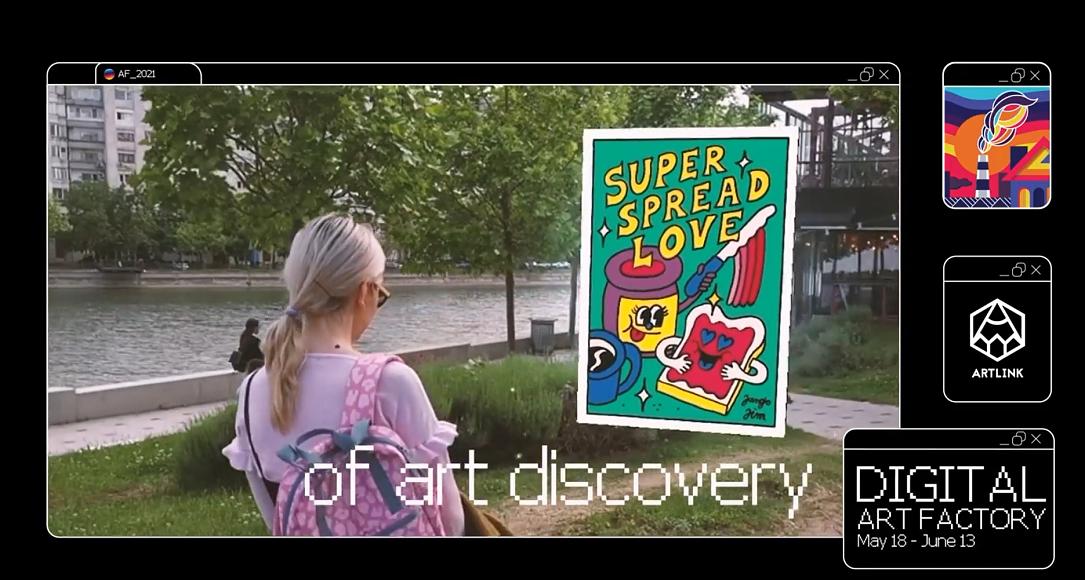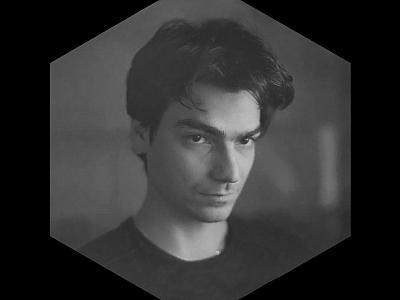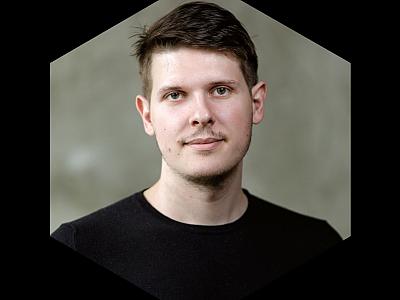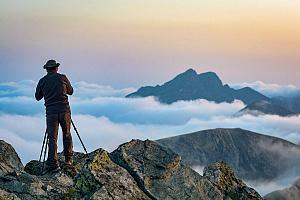Bringing the exhibition into your home: RO duo develop augmented reality app for the arts sector

Visiting an art exhibition from one's living room? No more competing for viewing space? ArtLink, an app developed by a Romanian duo, makes that possible. Using augmented reality, it offers users the option to explore artworks and art events anywhere, anytime. Among them is Art Factory, a contemporary art festival presenting an AR edition in the app.
In 2018, Bogdan Topîrceanu, one half of the team behind ArtLink, was working on Art Factory, a contemporary art festival he founded which aims to revive abandoned industrial venues. He was facing a dilemma: the festival had a 75 sqm hall available but more good artists running in the open call than they could host. The same year, at a hackathon organized by Fine Acts, one of the largest NGOs in Bulgaria, he met Dragoș Silion. They were on different teams and worked on different projects, but after the event, Topîrceanu contacted Silion, having seen his work on an AR app and wanting to see if they could work together. They could, and the two are now working to explore the potential of AR in the arts sector.
Augmented reality came up as the answer to hosting more artists than the festival's venue allowed. After experimenting with the solution, the pandemic acted as a catalyst to launch the AR app.
"When the pandemic hit, we realized that everything was closing and we couldn't do anything anymore. I'm also a visual artist and had the same issue: 'Where can we exhibit from now on?' And we thought 'couldn't we use this experience of 2018 and transform it into something more to be able to host more artists directly in the app and offer an experience similar to a gallery or a museum?' At the time, all the cultural institutions had closed during the lockdown, and it was difficult to have access to them," Topîrceanu recalls.
Enter ArtLink, a solution for the Covid-19 cultural crisis, as its founders describe it. It aims to help visual artists, museums and galleries keep in touch with their public through augmented reality by offering the audience the possibility to explore high-resolution art exhibitions from the safety of their home.
"We started developing the project in March of last year, when we outlined a clear idea, did the first design, and, step by step, we launched an MPV (minimum viable product) in July for Android, continued with iOS in August and, bit by bit, we started adding content, talked to artists, to various events and built the app as it is today," Topîrceanu explains.
Once the platform was up and running, it could be offered to other projects interested in a virtual display space. Digital Art Factory, the AR version of Art Factory currently hosted by ArtLink, came as a natural extension of the project, also given the current context, when the cultural offering is only slowly going back to normal and restrictions persist.
Last year, the app hosted its first festival: Diploma. The project, initiated by The Institute, focuses on showcasing to a broader public the graduating works of students of creative and vocational schools. At the time, the number of Covid-19 cases was fluctuating, casting uncertainty on the circumstance and conditions for organizing the event. The app allowed the organizers to "double" the festival in AR for those who were not able to reach the event physically or were concerned about the risks, the team behind ArtLink explains.
They also collaborated with two private schools and uploaded the works of the children, putting together an end-of-semester exhibition with their activities. It was also one of the platforms hosting a series of NFTs shown at the 93rd Academy Awards to benefit the World Wildlife Fund (WWF). Another partner is Fine Acts, which made available for the Digital Art Factory festival a gallery encompassing artists from across the European Union. At the same time, they are working on animating physical images. In a few weeks, users of the app will be able to scan the cover of a volume and see it coming to life as the image on the cover triggers an animation.
Offering the platform to various events or organizations is a way to monetize the solution, which is free for artists and users at the moment. The artists who want to register on the app need to go through the ArtLink selection part. The team is working on curating the available content to make sure the platform remains one for art and that those who show the works are indeed the actual artists, and that quality content is made available.
How does it work?
The app revolves around the camera. After opening it, the user can see a summary of the content. They can click on each gallery, and there is a scroll menu with all the details, including about the artist and a large 'Go to AR' button. After pressing it, the camera opens, and users find the instructions for each step. First, they need to scan a textured floor or a nearby wall, click on the surface, and the work emerges floating one meter and a half up in the air.
"It is displayed at one meter and a half just as it would be on a regular display in a gallery or museum. The interaction is just like one in a gallery: the work is static, you can come near it with the phone to see details, you move away. There are haptic functions as well, you can pinch the work and zoom in, but for more details the easiest is to get closer with the device to see all the details," Topîrceanu explains.
The layout of the app has just received an update and was undergoing testing at the time of this interview. "We plan to experiment more with various galleries and try all sorts of things, besides 2D paintings or 2D animations, which don't use the technology at its full potential," Silion says.
The technology can render complex 3D models that allow users to take a walk inside them. Something users can experience while checking out the works of children from two schools in Bucharest the app currently hosts. "There are all sorts of characters or landscapes that they tried to do. The children from Rubik did some complex buildings that are also furnished; they are sorts of dollhouses that you can enter and see the details of each room, or small villages and you can see the details of every house," he explains.
The education-related aspect is part of the project's wider mission "to make art accessible anytime anywhere, and reach communities with little or no access to cultural institutions," something the team would like to further develop in time. "The technology helps us reach underprivileged persons, to bring culture and technology and education to isolated communities, and can be in the long-term a learning platform. You can enter and see contemporary works, but, depending on the partnerships we will have with museums, also classical exhibitions where children can learn art history or see how the respective works were painted or sculpted," Topîrceanu adds.
With the app launched last year, the team has focused so far on artists and festivals but plans to tackle the segments of galleries and museums as well. As for the feedback received so far, they point to a technological gap. "The artists and most users have not yet tested very many augmented reality apps, and they are still trying things. This is why most of the works we have are 2D, even though the technology allows for an immersive 3D experience where things happen, and you interact with them," Silion explains.
Topîrceanu also points to the digital's status in the educational system. "I've experienced the entire system, and the digital part is not very present. And where it is present, it is not taught in a way that would leave you with some practical abilities. Everything is presented very fast, more at a theoretical level, and no one has the patience to explain how every digital component works. Even if you went to school, you still need to learn by yourself, from square one, everything related to the new digital media."
Still, the overall feedback is a positive one, the team says, pointing to a learning process on both sides and to their availability to work with artists to implement their suggestions. "Once they understand how things work, the feedback is good, and I think we can convince more and more artists to switch from the 2D canvas and test other things. […] The feedback is good, but we are still learning how they think, they learn how our app works," Silion says.
Regarding museums, they plan to highlight the new public the app can help them reach. "We think there is an interest for museums as well to access this technology because everyone is somehow limited by their location," Topîrceanu explains. The app would be a solution "if someone wants to go and see works in the United States, let's say, but maybe does not have EUR 1,000 to pay for the plane ticket but would like to see a selection of works in augmented reality or an exhibition the museum has at that time and would be willing to pay a ticket that is cheaper than the plane ticket, straight from the phone."
A virtual celebration of art
Unlike other previous editions of Art Factory, an open call wasn't organized for this year's digital edition to help streamline the process and overcome any technical glitches. "Usually, at the physical editions of the festival, we had some established topics, did an open call, we're waiting for the works to come and gave the results after a period of selection. This time, we contacted them [the artists] because people are not familiar with the type of environment. We didn't know exactly what kind of works we would receive, if technically they would be able to photograph or scan them at the required standard, and we thought about doing the research ourselves and reaching out to the artists. We eliminated the topic precisely because of this, because we tried to look for artists who had works that already fit the festival," Topîrceanu says.
Still, there is an overarching topic for the event: "the celebration of art." "We didn't want to go beyond this; we simply wanted to bring this festival into the lives of people so that they can reconnect to the entire artistic environment which slowly started to come round, but there are still very few events and little cultural content we can attend at this point, our advantage being that you can attend it wherever there is internet," he says.
As for a physical edition of the festival, the option is on the table, but the uncertainty induced by the pandemic makes it hard to announce such plans. "It is an option we are considering, but we can't guarantee it for the time being because we don't know what the pandemic will look like. At the same time, this is a different story because it is rather difficult to find industrial venues that want to get involved culturally. It remains to be seen. For the time being, we want to see how far we can go with this app […] we would also want to show what can be done in a hybrid mode, to augment real content, not just have future galleries," he explains.
Besides the work on the app, the past year also brought increased interest in the potential of AR and more contacts and the start of various collaborations. "As an AR/VR developer and freelancer, it's been a very good period for me. More people want to experiment with this; leaving aside the fact that a pandemic is never a positive thing, for this field it was a catalyst allowing more people to experiment with this type of technology. There were more people open to discussions; just as we've met more people on Zoom, they also started to meet in virtual reality," Dragoș Silion says, also mentioning the work he did on a fundraising event that took place on a 3D stage.
As for Bogdan Topîrceanu, it was a period of learning. "On the artistic side, it was a period of learning. Throughout the year, I've updated myself on AR and VR-related aspects, I managed to develop more skills on the technology side, and I plan to learn even more. At the same time, it was a learning experience on the project management side because, going through the two incubators, I had to map out a study schedule almost as the one I had while at university. And even if I wasn't working specifically on the app, I was working on something related to the app, so I had to learn to multitask and keep everything in balance; it was a period of personal growth, even if I spent a lot of time inside, this was the downside of the period, I've experienced a period of personal growth, and this was very good."
Meanwhile, they remain open to collaborations. "We are open to collaboration with art and culture institutions. The festival runs until June 13th. Until then, we will keep publishing galleries every day. Afterwards, the festival will be available for a while because there is a selection of more than 100 new artists in the app, and we want as many people as possible to come into contact with the artists we uploaded. Even if the event ends, the content is there and will remain accessible for a while," Topîrceanu adds.
The ArtLink app is available for download here. A presentation video of the festival is available here.
Bogdan Topîrceanu is the founder of Art Factory, a contemporary art festival aiming to revive abandoned spaces. He holds a Ph.D. in Visual Arts and a Degree in Pedagogy. He is currently teaching art and building his design studio, as well as developing ArtLink, which represents a culmination of his interests in art and technology.
Dragoș Silion developed Werit.ro, a fashion aggregator which, using AI, created custom outfits for customers. With this idea, he won the Best Pitch Award in the 2017 edition of Innovation Labs. He is a laboratory teacher for the Introduction into Mixed Reality course at UAIC Computer Science Faculty in Iași. He has also created insidar.tech, an AR orientation app for indoor spaces, and many other AR and VR applications in fields of education, staff training, and also marketing campaigns.
(All photos courtesy of ArtLink)
simona@romania-insider.com















